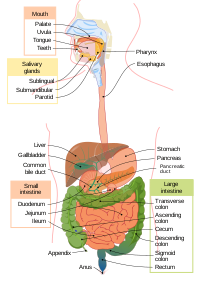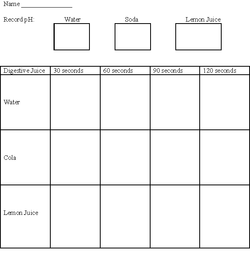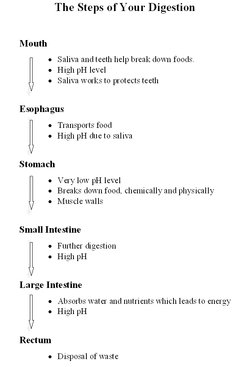Digestion Detectives
| Instant wiki maker | Making handouts | Editing tips |
Biology In Elementary Schools is a Saint Michael's College student project from a course that ran between 2007 and 2010 and fully described in this book chapter. The student-created resources have been preserved here for posterity. Link under 'toolbox' for printer-friendly versions of the exercises. Click on handouts to print full resolution versions. Please see Wikieducator's disclaimer, our safety statement, and the Creative Commons licensing in English and in legalese.
Student worthiness
Activity completed by several small groups of students in grade three and it went well!
Primary biological content area covered
Students will be exposed to stomach digestion through a fun and engaging experiment. They will observe various levels of pH and its effect in chemical break down in the digestive system. Students will be expected to create a hypothesis as well as regularly record observations as each solvent breaks down the "meal."
Materials
Materials account for a class of 30 students
- Loaf of white bread (Notes: If there are 40 students it may require 2 or 3 loaves of bread)
- Lemon Juice (100mL)
- Water (100mL)
- Soda (100mL)
- Sealing Sandwich Bags (36)
- Small Beakers (3)
- Litmus Paper (3)
- Stopwatch/Timer
- Handout/Graphic Organizer
(sink nearby)
<kaltura-widget kalturaid='0_rd1zvyb7' size='L' align='R'/>
Handouts
The first worksheet is given to enable students to record their observations and data during the experiment.
The second will be given to the students prior to the experiment to help explain pH level and the pH levels during different stages of digestion.
The third handout will be given to the students after the experiment that explains the different parts of the digestion system.
Description of activity
This activity is designed to let students further their understanding of the digestive system and how the stomach digests food. In addition, students will learn about pH levels and their connection to digestion.
Lesson plan
- Prior to beginning the experiment, ask the students to describe how they believe the digestion process works. After a brief discussion explain the directions for the experiment. Then have each student write down his/her hypothesis.
- Measure 100 mL of each liquid (water, lemon juice, and cola) into a beaker. This will need to be done twice for each liquid.
- Measure and record the pH level of each of the three liquids onto the hand-out.
- Assuming that you are working with small groups of six students at a time, divide the group into three pairs. This will help give each student an equal opportunity to participate.
- Each pair will have two pieces of bread, and two quantities of one of the three liquids. Place one piece of bread in each plastic bag, pour the liquid into the bag, and seal the bag making sure that all of the air is removed.
- Each pair will have a stop watch - start the stopwatch and let it run for five minutes. During the five minutes, one student in the pair is responsible for "churning" one of the bags so that the bread is able to break apart, and possibly dissolve in the liquid. (The churning of the bag represents the process of the stomach during digestion) The other student in the pair is responsible for observing the bag that is not being churned. After intervals of one to two minutes, students will record their observations on a handout.
- After five minutes, have each pair share their observations and everyone else in the group will record the information.
- Ask students to compare the pH levels of each liquid and discuss the process of digestion using the different liquids, as well as what happened when the bag was churned or not churned.
- After completing the activity, dispose of all plastic bags, and make sure to wash and dry all of the beakers. Wipe down the counters in case there was any leakage from the bags.
Potential pitfalls
Make sure that the sandwich bags are tightly sealed before beginning the "digestive" process.
It's important to remember that the data might be skewed for some students churn the bags more aggressively than others.
Math connections
This lesson provides an opportunity to introduce the concept of exponents, because the pH scale is an exponential scale of charges. This lesson also provides students with the opportunity to practice measuring liquids in mL with the plastic beaker.
Literature connections
- Guts: Our Digestive System: This non-fiction book is full of graphic pictures and text to help students learn and understand their digestive system.
- Simon, Seymour. Guts: Our Digestive System. New York: Harper Collins Publishers. (2005).
Connections to educational standards
7.14 Human Body: Students demonstrate understanding of the human body-and understand the impact of the environment on the human body. This is evident when students: 7.14b Identify the parts of the human body, and demonstrate understanding of how the parts work together to perform functions that satisfy common needs. 7.14c Identify and describe environmental factors that can influence human health.
7.1 Scientific Method: Students use scientific methods to describe, investigate, explain phenomena, and raise questions in order to: deduce the expected results; and gather and analyze data to compare the actual results to the expected outcomes. This is evident when students: 7.1 a. Ask questions about objects, organisms, and events in the world around them.
1.20 Communication of Data: Students use graphs, charts, and other visual presentations to communicate data accurately and appropriately.
Next steps
This activity is designed to inspire students to investigate what we've touched on further. Classes could examine pH levels more in depth or human nutrition. This experience also easily leads into the next stages of the digestive system.
Reflections
This activity was very well received by all of the participants. It was fascinating the degree of knowledge many students had about their stomach and their understanding of the importance of stomach acid. Students were also able to make connections between the level of pH and the impact that the solution would have on the bread. Many understood that the lower the pH, the faster the bread would break down. Our discussions were lively and students made connections to their own bodies, which was our aim. It was interesting to compare different groups results, because some students were more aggressive when they churned the bread, which affected which liquid broke the bread down the fastest.
Our group reflection came up with a few changes we would make to the activity, most technical. The set up needed for each group was so distracting for students that it was difficult for many to participate in the introductory discussion. We also had too many students to have them measure the solvents themselves but it would have been nice if they could have participated in that aspect.
Citations and links
The original idea came from:
"Digestive System-zip lock stomach insulator." Pro Teacher Collection. Pro Teacher.org, 2008. Web 12 Jan. 2010. <http://www.proteacher.org>.









